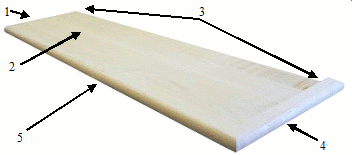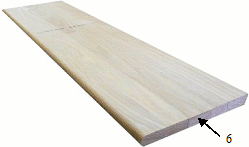All standard stair treads are 11 ½" deep X 1" thick X (length specified). Acceptable tolerances are +/- 1/32" on depth and 1/64" on thickness. Tread ends are not end cut and average ½" –1/8" over finished size to allow custom fitting in the field. Stair-Treads.com also end seals every board used to manufacture our treads. End cutting would remove the sealant and render this important step in manufacturing treads obsolete (see Why We Don’t Flush Cut Tread Ends). All treads are guaranteed to meet select-grade on one face. Therefore "A" face is select and "B" face allows sound defects. Single return treads must be specified left or right hand and are based on an over all length measurement. "Left" and "Right" are relative as you face the step. and Double return treads are based on a "throat" dimension. All Bull Nose (aka starter step) and double Bull Nose assemblies are based on a throat dimension.


- Walled End - This end of the stair tread is placed against the wall and can also be referred to as the "closed end."
- Face - The finished walking surface of the stair tread.
- Throat - The opening of the stair tread. This dimension is important for single return treads and is the most important measurement on double return treads.
Note: Single return treads are measured by the Overall length. Example: a 42" left return tread is 42" long overall and has a 40-3/4" throat (42" tread - 1-1/4" return )
- Return -This is a 1-1/4" solid stave that is bullnosed on one side and glued to fit along the open end of the stair tread. This allows a pleasing visual and simulates the appearance of penetration into the staircase when viewed from the side. Typically a return tread is only used when pickets from the handrail directly intersect the stair tread. The side of the tread that has a return is referred to as the "open end."
- Bullnose - The rounded surface or "nose" of each tread. Found along the front edge and also along side edges of return treads.
- Stave - A single solid piece of wood that is glued together with other staves to form the solid stair tread.
What information do I need when measuring a job?
When measuring a stair case for prefinished stair tread installation, three pieces of information are needed:
- Length
- The length of a tread is always determined by measuring the overall length of box treads and single return treads. Double return treads are measured by the throat length. Do not include the returns as part of the double return tread measurement. Since the mitered returns are always 1-1/4" wide, adding the return width is redundant. Prefinished stair treads are sold in 6" increments beginning at 36" (42" for single return treads). If in doubt, order the next larger size.
- Product Match
- Or wood species if the tread is finished natural. The flooring product to be matched is necessary to ensure a proper color and sheen level. If the tread is a natural product such as Red Oak, Maple, Brazilian Cherry, etc, this will simple be noted as "Natural" and the species. i.e. Natural Maple, Bruce Butterscotch, or Jamestown Winchester
- Type
- A notation of "Closed" is sufficient for closed or box treads. "Right Hand Open" or "Left Hand Open" must be specified for single return treads and "Double Side Open" suffices for double return treads.










Log In